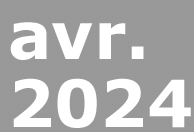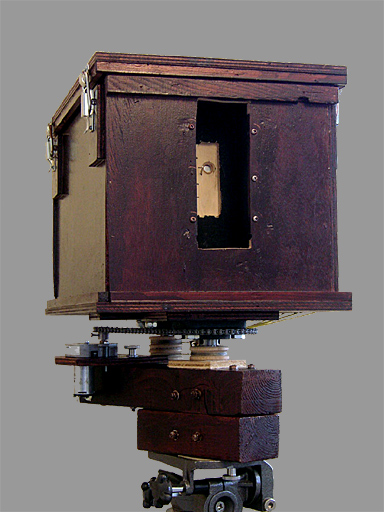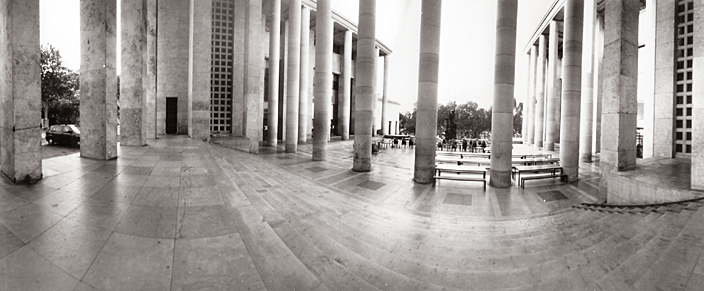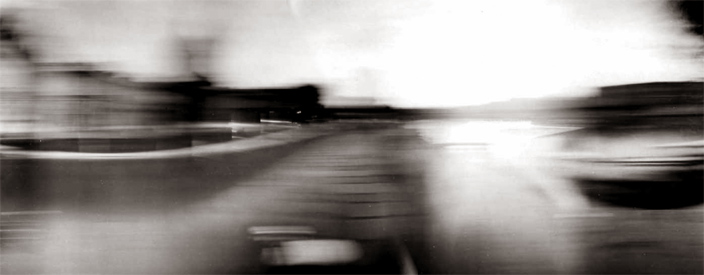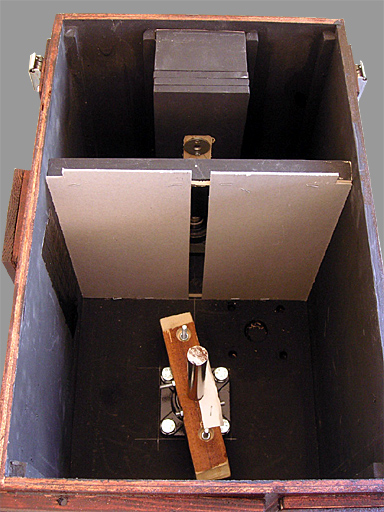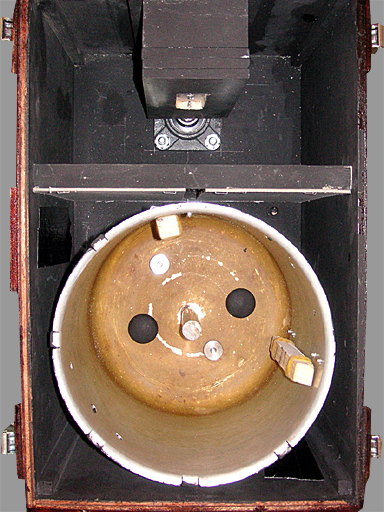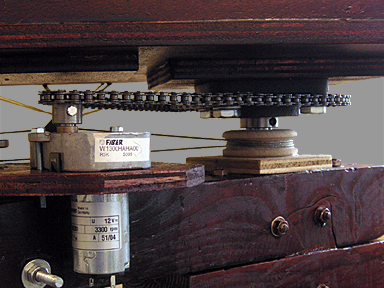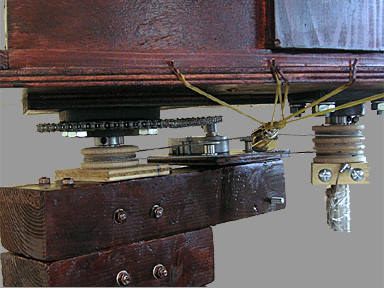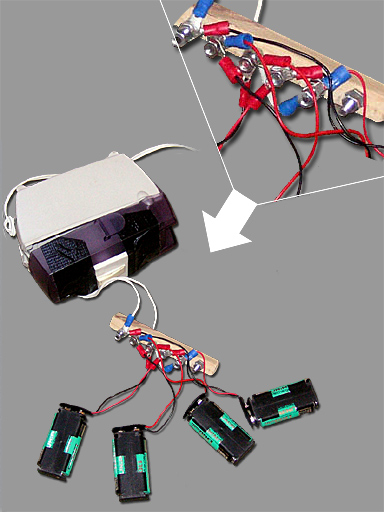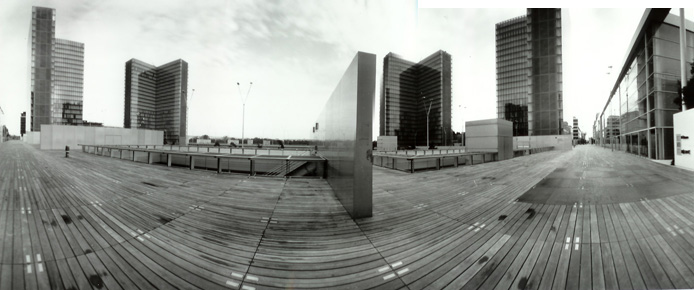|
|
|||||||||||||||||||||||||||
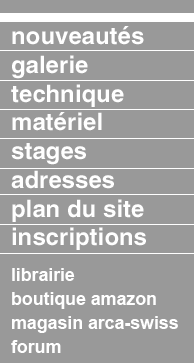
l'auteur
|
Speaking in praise
|
||||||||||||||||||||||||||
|
|
|||||||||||||||||||||||||||
|
The principles are simple, however the design and fabrication needed hard work: I did not find the right solution at the first attempt. The first version was somewhat naive, I imagined that the pinhole would rotate around a fixed drum; the result was disconcerting: a perfectly abstract image on a magnificent film... As an example, the sun, which you can only guess through the clouds, had left a weakly concave arc-shaped image on top of the film, spreading across about one quarter of the image... and the rest exhibited a very similar strange look, upward concave circular arcs on top of the image, downward concave arcs in the bottom part of the image. All those interlaced arcs totally blurred the image. The next version of the camera also delivered strange images, however with a much less abstract character:
I really liked those images, however this was not the goal of the initial project! The final result is not really a crude do-it-yourself device made with scotch tape and pieces of string, however it is not a fine watchmaker's-style piece of craftsmanship, eligible for a permanent exhibition in a museum of science and technology (a museum like the Musée des Arts et Métiers in Paris). Technical specificationsMy roto-pinhole camera was built with a "focal length" which is not really an ultra-wide angle; this is a personal aesthetic choice, a similar type of construction can be made with any other choice of pinhole focal length. For similar reasons, I limited the panoramic angle of view to 240°, however a full 360° circle could be easily reached using longer pieces of film. - film format : 8"x20" i.e. 20.3 x 50.4cm The camera in images
The pinhole is located just above the principal rotation axis. The film is located on the outer side of a rotating drum moving around a secondary axis; the exposure is made through a thin vertical slit. (the drum, the heart of the system, is a vintage stewpan bought in a flea-market !)
The whole camera is rotated by a small electrical motor fitted with and important geared reduction system, a "moto-reducer", transmission is achieved with a chain. The cable located under the chain actuates the drum film holder when the camera rotates.
Speed adjustments are made using different combination of voltages provided by a set of batteries connected in series or in parallel : 3 speeds are available, corresponding to 3 voltages (240° are achieved in 18, 6 or 3 minutes for 3, 6 or 12 volts).
Although the camera works perfectly and delivers very interesting images, this prototype still exhibits many drawbacks: it is very bulky, sensitive to wind, exposure times are long, only a single shot is possible per "shooting session"... For those reasons, I am thinking of a successor design using home-cut large format rollfilms in order to cure all these disadvantages (may be a "packet-size" version using 4"x10" films suitable for contact printing !) A few hints for the adventurersAppendix 1 : panoramic cameras and large format pinhole camerasThis short recension does not aim to exhaustiveness, but only to stimulate curiosity ; I purportedly left aside all conventional panoramic cameras that are described for example, in the excellent book by Arnaud Frich [3] la photographie panoramique, Eyrolles 2004. Hexagonal-shaped panoramic pinhole cameras : Another camera, still a prototype : the "hexomniscope" [5]http://www.abelsonscopeworks.com/cameras/hexomniscope.htm A few results with multiple-shot panoramic pinhole cameras : [7]http://www.casadopinhole.com/ovni_eng.htm Craig J Barber : [8] http://www.craigbarber.com/gallery.html Panoramic pinholes made with a semi-circular "camembert-shaped" box : Kurt Mottweiler : [9]http://www.mottweilerstudio.com/html/cameras/camera_6.html Semi-circular "camembert-shaped" large format cameras fitted with conventional lenses: Tom Yanul : [10]http://hometown.aol.com/tyanul/myhomepage/profile.html Rotating panoramic pinhole cameras : pinhole camera with 120 film, a camera by Robert Lang, cf page 189-191 of Eric Renner's book, [11] Pinhole photography, 3-rd edition 2004. small and medium format cameras : [12]http://www.tbk.de/panorama/show1.htm home-made : Doug Bardell [13]http://www.cyberbeach.net/~dbardell/panoptic.html large format cameras : The Kodak cirkut camera: [14]
http://www.bigshotz.co.nz/cirkut.html Another link showing a video recorded during a shooting session : [15] http://memory.loc.gov/ammem/collections/panoramic_photo/pnshoot.html Jamie Youg explains how to print large rollfilm negatives made with a "Kodak cirkut camera" with alternative photographic processes: [16] http://www.jamieyoungphoto.com/jamie%20young%20%20cikt2.html semi-spherical panoramic shots with a mirror : [17]http://www.tbk.de/panorama/show3.htm Pinhole cameras : The "moonscapes" by Eric Renner: 4 images on 120-film, with anamorphic images : [18] http://www.pinholeresource.com/agora/agora.cgi? cart_id=&xm=on&product=Cameras The mode of operation of rotating pinhole cameras by Oward Romero is mysterious... [19]http://www.panscenic.com/cameras.htm Appendix 2 : where to find large format film (the point of view of an European LF photographer)I have used 16"x20" film (40.6 x 50.8 mm) cut in two halves to yield a final 8"x20" format. In ASA 100, One of the readily available films is supplied by MACO, Germany (the company offers numerous other formats up to 20"x24"). MACO's web site dedicated to film products: [20] http://www.mahn.net/Frameset.htm ; a direct order is now possible. An alternative is to use Efke film, that can be ordered for example from JandC Photo in the USA: [21] http://www.jandcphoto.com/index.asp?PageAction=VIEWCATS&Category=69 In ASA 400, JandC offer their own "JandC" brand. [22]http://www.jandcphoto.com/index.asp?PageAction=VIEWCATS&Category=69 Custom-made film cut on special order, at a nominal charge and important delivery period, can be obtained from: Bergger : [23] http://bergger.com/ Wephota : [24] http://www.banse-grohmann.de/wephota/sortimix.htm Let us remind to those who wish to use ultra-large formats, that there are actually alternatives to contact-print-only, as shown by this model of 16"x20" enlarger by Mike Westmoreland: [25] http://www.bigshotz.co.nz/mike_westmoreland.html As a conclusion to this "panoramic" review, let us pay tribute to one of the bravest of our predecessors, Melvin Vaniman ! [26] http://www.bigshotz.co.nz/melvin_vaniman.html PS : small-hole aficionados are usually not ready to comply with the hard laws of optics; however they may have some interest in reading this article by Emmanuel Bigler "How to optimise your pinhole camera". Doing so, they will be ready to infringe these laws with due knowledge ! |
|||||||||||||||||||||||||||
|
|
|||||||||||||||||||||||||||
|
|||||||||||||||||||||||||||

